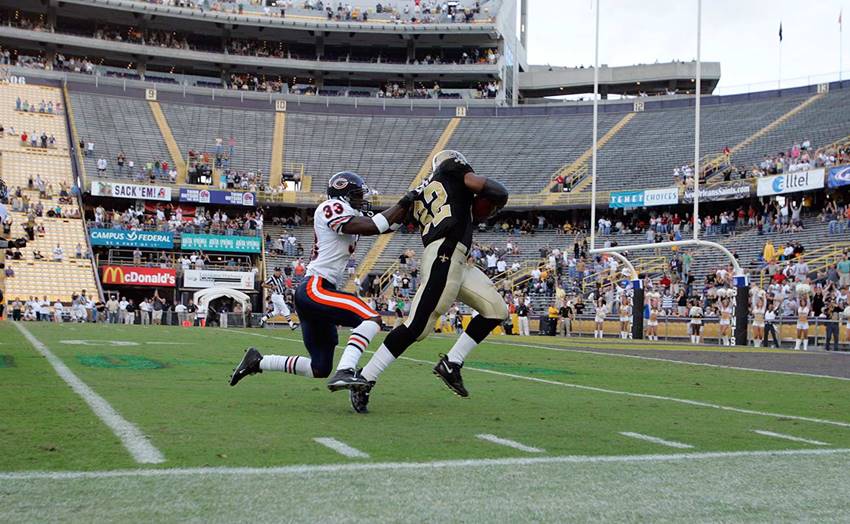Football in southeast Louisiana no stranger to impacts from hurricanes

On a September night in 1998, Interstate 10 between New Orleans and Baton Rouge was packed.
Long before something called contraflow, you would think fans would be headed out of town to duck the pending arrival of Hurricane Georges.
But thousands were doing something they considered far more important.
They were on their way to Tiger Stadium.
A crowd of 80,000 packed the famed arena to watch LSU rout Idaho, 53-20. On homecoming, LSU coach Gerry DiNardo ran his record at the school to 29-9-1.
The following Monday and Tuesday, school was closed for the hurricane. Meanwhile, it was all sunshine for the occasionally glib LSU football coach.
“My scouting report says to relax,” DiNardo told the Shreveport times.
Georges unexpectedly turned north, brushing the Louisiana coast and making landfall in Mississippi.
For DiNardo, the storm was just beginning.
The following Saturday night, LSU lost at home to Georgia 28-27.
The Tigers went on to drop seven of their last eight games.
Football and hurricanes are inexorably linked in south Louisiana lore.
In October of 1964, Hurricane Hilda threatened the Louisiana coast.
LSU director of athletics Jim Corbett asked the University of Florida team to fly to Jackson, Mississippi in hopes that the storm would turn and the Gators could bus to Baton Rouge.
Hilda had other plans.
The game was moved to December, and LSU played poorly.
On a chilly night in Baton Rouge, Steve Spurrier threw a touchdown pass in 20-6 win for his Gators over the Tigers. Florida ended a touchdown drought against LSU that had stretched back to 1960.
On the night Hilda was supposed to hit southeast Louisiana, Tulane was scheduled to host Duke.
The game played later that season was a 17-0 Tulane win. The Greenies won their third game of the season in what looked like a sign of solid improvement for the Green Wave under head coach Tommy O’Boyle. The previous season, the Green Wave was 1-8-1, scoring 43 points the entire year.
O’Boyle was fired a year later. The Duke victory was one of just six in his four seasons at the helm.
A decade later, Hurricane Carmen threatened the Louisiana coast.
Tulane, in its opener was favored against Ole Miss, scheduled to make its debut for new head coach Ken Cooper.
The game was postponed because of the storm.
The Wave, coming off a nine-win season, won its first five of 1974. In game six, star quarterback Steve Foley suffered a broken leg in a game at Georgia Tech.
Tulane lost its last six, including the final game the school would play at old Tulane Stadium. Ole Miss snapped a seven-game losing streak with a 26-10 victory.
In 2005, Katrina ravaged New Orleans and the Gulf Coast. Many in the media called for the Saints final preseason game at Oakland to be cancelled.
However, the game was played and the Raiders won it, 13-6.
The Saints trained at San Jose State during the week, and then moved on to set up shop in San Antonio.
New Orleans lost 13 games that season. Head coach Jim Haslett was fired, making way for a re-birth for the football team and its city.
That same season, Tulane was expected to have one its better teams since the unbeaten 1998 season. Playing all 11 games on the road, the Green Wave won two of them.
Head coach Chris Scelfo often wondered just what that team could have accomplished. He was reminded that lots of things can go wrong in a football season, and some are powerful and way beyond a coach’s control.
Regardless of what happens this year in the tropics, 2020 is already a prime example of that.
- < PREV Recruiting: Elinus Noel III of John Curtis commits to Lamar football
- NEXT > All 2020 Saints draft picks should stick and contribute
Ed Daniels
WGNO Sports Director/106.1 FM
Ed is a New Orleans native, born at Baptist Hospital. He graduated Rummel High School, class of 1975, and subsequently graduated from Loyola University. Ed started in TV in 1977 as first sports intern at WVUE Channel 8. He became Sports Director at KPLC TV Channel 7 in Lake Charles in 1980. In 1982 he was hired as sports reporter…





